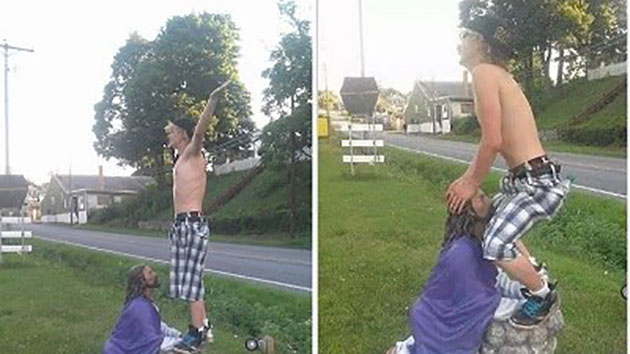Is symbolic behavior a crime when it may offend religious sensitivities? A 14-year-old boy could be facing up to two years in juvenile detention for posting lewd, crass, yet ultimately innocuous photos on Facebook this past July. The problem: the photos featured him suggestively posing with a sculpture of Jesus.
While traipsing the lawn of a local religious organization known as “Love in the Name of Christ,” the teen, who resides in the town of Everett, PA decided it’d be funny to pose with a statue of Jesus. It’s a small statue of Jesus kneeling in front of a fountain, not unlike what one would typically find in a flea market. In one picture, the teen is pictured shoving Jesus’ face into his crotch, simulating fellatio. In another, the teen victoriously hurls his hands up in the air, with all the smug post-blowjob glory of a frat boy.
The teen’s act of transgression appears to be a thoroughly unimaginative case of hormonal overexcitement, coupled with a familiar teen need to push the boundaries. Perhaps the kid had just had it with organized religion. Whatever the case, the sculpture survived unscathed. However, local Pennsylvania authorities have bafflingly argued that the offense caused by the kid’s action is itself grounds for a criminal prosecution. To bolster these claims, they’ve invoked an antiquated, vaguely-worded – and very likely unconstitutional – 1972 state law that punishes “physically mistreating [any public monument or structure, or place of worship or burial] in a way that the actor knows will outrage the sensibilities of persons likely to observe or discover the action.” Really? What about giving Jesus the bird? Would that land someone in jail? As Sara Rose of the ACLU rightly points out, punishing the mere act of gesturing against a “revered” figure violates First Amendment principles, particularly the Establishment Clause.
Symbolic action is a kind of speech – no matter how disagreeable or stupid some may find it – that is still protected for its expressive value. Pennsylvania seems to be lagging behind in realizing this imperative. The state also classifies the desecration of a flag as a misdemeanor. Earlier this year, Joshua Brubaker, an activist and supporter of the American Indian Movement, faced a heavy fine and jail sentence after hanging a United States flag upside-down outside his own home, decorating it with the letters “AIM”. The Supreme Court, however, has repeatedly ruled the symbolic act of burning or otherwise “desecrating” the flag a type of expression protected by the First Amendment.
It may be time for Bedford County’s Senior District Attorney William Higgins to get the message – symbolic expression does not warrant criminal charges just because it may offend some part of the community.
Stay tuned for updates.


